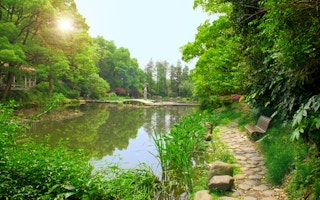A hardy, fast-growing grass known as “lu xin” (green heart) may be a welcome new addition to the world’s arsenal in the war against climate change.
The grass acts like a carbon sponge, capturing much higher levels of carbon dioxide than trees, according to Lei Xuejun, director of the Carbon Cycle Research Center at the Central South University of Forestry and Technology in central China’s Hunan Province.
Lei is in Paris this week for the COP21 climate change conference. He first cultivated the hybrid grass in 2013 and has led research ever since.
Hunan’s Changsha County was quick to identify the potential of the grass in its zero-carbon strategy. Over the past two years, Changsha has allocated over 20 hectares for planting and given Lei’s team financial support to optimize the carbon-capture vegetation.
The grass, similar in appearance to sugarcane or sorghum, regrows rapidly after cutting, and can grow three to five rounds a year. The crop can be ground and processed into standard carbon products like paper, construction materials and fertilizers. The grass is able to withstand high temperatures and drought, and can survive in poor soil.
Every hectare of the grass can absorb and solidify over 200 tons of carbon dioxide every year, whereas trees hold 15 tons per hectare annually.
The grass can lower the cost of carbon capture and storage, and reduce the concentration of carbon dioxide in the atmosphere, said Xu Heping from the Ministry of Science.
Changsha hopes that by expanding the grassland, establishing a carbon exchange system and reducing carbon emissions, the industrial county will achieve zero-carbon growth, according to Yang Yiwen, chief of the county committee of the Communist Party of China.
Lei said the county must now develop an industrial chain that will make cultivation of the grass profitable, and encourage farmers to plant it.
The local government also plans to introduce standard carbon products made from the grass into the carbon trading market, Yang said, meaning that polluting companies can purchase carbon products to offset their emissions.
There are, however, doubts about the merits of the grass. Wang Guangjun, a professor of ecology and colleague of Lei, told a Hunan newspaper that the speed at which the grass grows could have negative side affects, as invasive species have been shown to unsettle the ecological balance.










